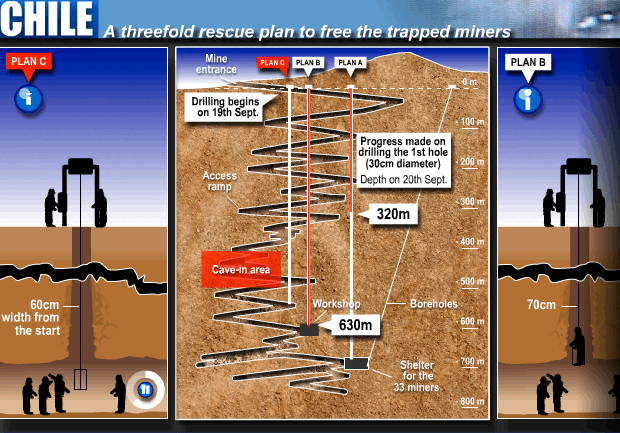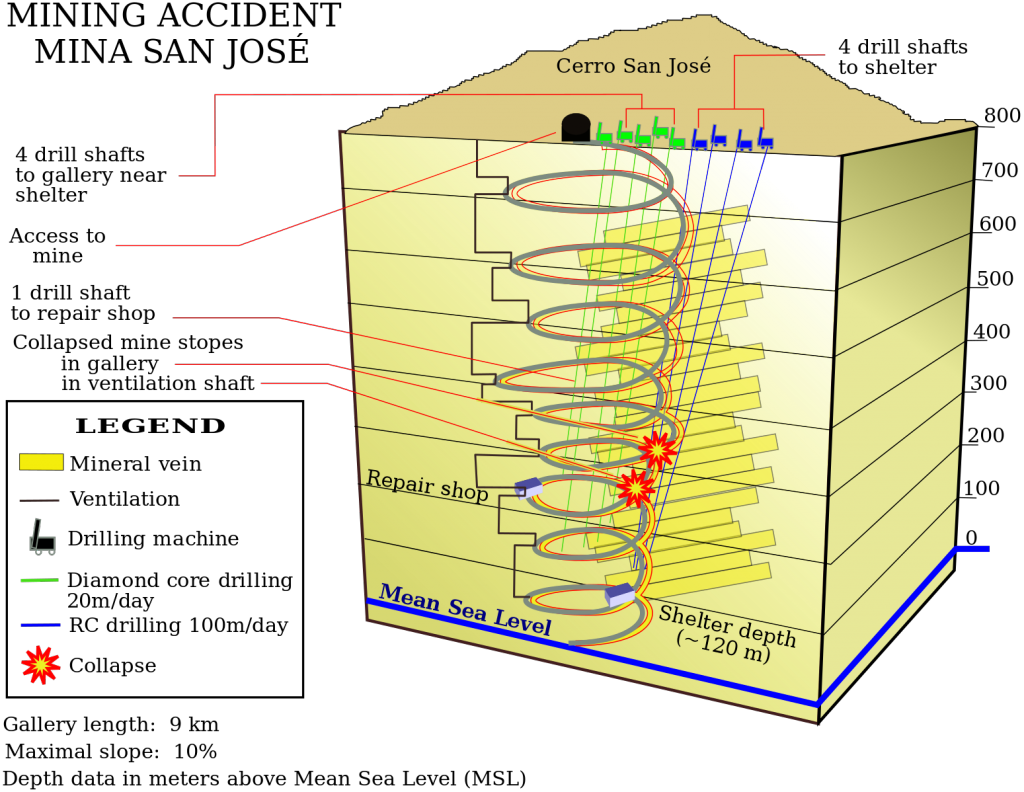Objectives
At the end of this lesson, students will be able to:
- Explain the use mine maps.
- Describe escapeways.
- Identify causes of mine emergencies.
- Explain fire in mines.
- Describe hazards of toxic gases in mines.
- Explain mine emergency warning systems.
- Summarize emergency evacuation systems.
Reading & Lecture
A mine map is a schematic drawing on paper of the mine workings, drawn according to scale and showing all important features of the mine. The mine map is designed by a competent engineer and is periodically updated to reflect all changes in the mine, such as new development areas, abandoned areas, or drill holes.
The mine map shows all important features of the mine. The following list represents the kinds of features that might be shown on the map. The actual contents of the map depend on important features at the mine.
- Name and address of the mine
- The scale and orientation of the map
- The property or boundary lines of the mine
- The adit shafts, stops, drifts, tunnels, entries, rooms, crosscuts, and all other excavations of the ore bed being mined
- All drill holes that penetrate the ore bed being mined
- Dip of the ore bed
- Any outcrop of the ore bed within the bounds of the property
- The elevations of tops and bottoms of shafts and slopes.
- The elevation of the floor at intervals of not more than two hundred feet for:
- At least one entry of each working section and one intersection.
- Developments advancing toward or adjacent to property or boundary lines or adjacent mines.
- Contour lines passing through whole number elevations of the ore bed being mined.
- Entries and air courses with the direction of air flow indicated by arrows, and location of fan controls.
- The location of all mine ventilation fans.
- Escapeways throughout all levels of the mine.
- The known underground workings in the same ore bed on the adjoining properties within one thousand feet of such mine workings and projections.
- The location and elevation of any body of water dammed in the mine or held back in any portion of the mine.
- The abandoned portion or portions of the aline.
- Mines above or below the mine workings.
- The location of any streams or bodies of water on the surface.
- Either producing or abandoned oil and gas wells located within five hundred feet of the mine.
- The location of all high pressure pipelines, high voltage power lines and roads.
- The location of railroad tracks and public highways leading to the mine and mine buildings of a permanent nature and showing identifying names.
- Where the overburden is less than one hundred feet, any dwellings.
- Major underground travelways and haulageways and ore passes at the mine.
- Major underground facilities including lunchrooms, refuge areas, mine shafts, shops, storage facilities (explosives, fuel, supply), and locations of underground telephones.
Mine Emergency Evacuation Video
Emergency Evacuation Video
Causes of Mine Emergencies
Accidental explosions
- Dynamite
- Fuel tanks
- Electrical Equipment
- Certain mine gases (hydrogen, methane, etc.)
Fire
- Timber
- Rubber tires
- Electrical equipment, including batteries and battery chargers
- Combustible metals, such as magnesium, titanium, zirconium, and sodium.
- Rubbish
- Petroleum products
Toxic gases
- Gases from undetonated explosives
- Gases from exploding batteries or other burning electrical equipment
- Fumes from certain petroleum products
- Gases from the ore itself
Loss of ventilation due to accidental failure of ventilation fans.
Inundation from water flooding into the mine.
Mine Warning System
Types of warning systems
- Visible – colored lights (red or blue, for example) mounted on stands in various parts of the mine.
- Audible – emergency alarms that can be heard over most mining equipment throughout the mine.
- Smell – stench canisters that release a chemical smelling like rotten eggs. The stench is carried through the mine by ventilation system and fills the entire mine within minutes.
- Mantrip drivers – drivers may give personal warnings to individual miners and pick them up for immediate transportation out of the mine.
Emergency Responses of a Miner
- The first thing to do in a mine emergency is warn other miners of the situation. Tell everyone to pass the word along so as to assure that all miners are aware of the emergency situation.
- Use your self-rescuer if the situation calls for it. In the event of a fire or explosion, put it on automatically in order to minimize your breathing carbon monoxide.
- Gather together in designated places according to the mine’s fire and evacuation plan. Stay together and remain calm.
- Provide first-aid to any injured miners. If any miners are unable to walk, use a first-aid stretcher or build age using whatever materials (planks, rods, fencing) are available.
- A supervisor should take charge of planning and organizing. Because of his experience and knowledge, you should respect and follow his orders. If no supervisor is present, one senior miner should take on the leadership of the group.
- If the phones are working, report your situation, location, and intentions to the dispatcher or operator. He may have some helpful information. If you are wearing your self-rescuer, do not remove it. You could use a code system such as the hoist signal system to communicate with the dispatcher by lightly hitting the phone with a tool.
Escapeways and Emergency Evacuation
- Your knowledge of the locations of all exits and escapeways from the mine is extremely important. If the main exit out of the mine is blocked, you must be familiar with the secondary route.
- Part 57-11-50 states that: “Every mine shall have two or more separate, properly maintained escapeways to the surface from the lowest levels which are so positioned that damage to one shall not lessen the effectiveness of the ethers”.
- Escapeways are periodically inspected and maintained in acceptable condition. The law requires that escapeways be maintained in a safe and travelable condition, and that they be marked with conspicuous and easily read direction signs that clearly indicate the ways of escape. For your reference, a mine map is posted at all shaft stations, and at all underground shops, lunchrooms, and other areas where miners congregate. You should know where these locations are from your working area.
- When an emergency occurs, you should attempt to reach fresh intake air above the fire or explosion. Air on the return side of the fire or explosion will contain carbon monoxide against which you should use your self-rescuer for protection.
- The final leg of your escape from the mine may be traveling an emergency hoist to the surface. Try to remain orderly and calm while waiting for the hoist, and keep your self-rescuer on if you are using it. Follow your supervisor’s orders, and let injured miners take the hoist first so that they can receive medical attention quickly.
- After you reach the surface, contact a supervisor or the mine operator immediately so he will know you are out of the mine.
- Emergency Evacuation Plan
- If you are going to evacuate, first try the route into the intake air so that you will be in fresh air. If that route is blocked, then try the secondary escapeway.
- You should carry your lunch bucket because you may need food if you are trapped or if you are forced to barricade.
- If the mine is full of dense smoke, use a rope if one is available to tie the miners in a line. Otherwise, keep close together so that no one gets lost from the group. Keep a look-out for fires or other hazardous conditions.
Trapped Miners in San Jose Mine, Chile


Video: An In-Situ Refuge Container Overview